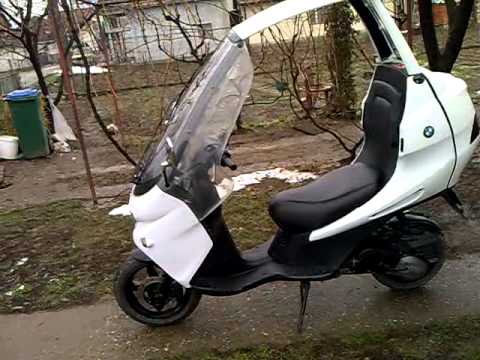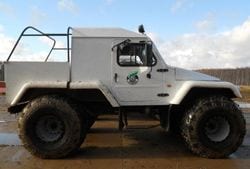
Benelli Adiva 125
So Benelli is following the same path that the Bavarians have already blazed with their C1 scooter. The challenge was taken up by Nicola Posio, who, as the Italian says, claims that two things are needed for pleasure. You know, her breasts on your back, hip to hip. . That's why Adiva is a scooter that can be transported in pairs under its roof. But that's not all: in good weather, the roof can be folded silently and quickly into a large trunk behind the seat. However, it is also true that safety in the event of a collision is not as important as in the case of a BMW.
The Adiva is still a classic scooter, so it doesn't have a tubular structure around the passengers or seat belts. This is not a very large or tall scooter, so it sits low and is ergonomic enough to feel comfortable. The driver is looking at a digital meter with a bunch of data, and only the large plexiglass panel acts as a screen, so it captures air too clearly, like a sail. She needs to get used to it!
The look of the car, with two taillights on an 80-litre boot, is a novelty inspired by first-class touring motorcycles and is a force to be reckoned with in everyday affairs. When you're rushing around the city center in the suit and uniform you need for work, you won't whiten your head with a parking space by putting your helmet and coat in a trunk that can easily fit a briefcase. with documents. And you don't care about bad weather. You can only blame the inaccurate lock that opens the trunk.
A person wandering into Adiva finds that the roof with the windshield is too low. Looking behind the steering wheel, part of the speedometer hides behind the steering wheel, and the legs seem to drag along the floor because of the low seat. Mirrors are satisfactory, look back too. The ability to install radio and speakers will delight those who cannot live without music.
The Adiva does not have seat belts, but the driving experience is similar to that of a BMW. They spend their time getting used to the more pronounced air waves from directions where the rider would not expect them. At higher speeds and with the roof open, side impacts cause impairment of sensation and deviation from the direction of travel in particular.
The plastic side shields proved to be a good solution. The softer hinges can become softer after hard braking, while the more sensitive ones will rub lightly on the softer suspension. The living Piagg unit (125 or 150 cm3) is highly flammable and works without interruptions. The unit is vigorous and quite voracious, and the final speed of about 100 km / h does not lag behind the C1.
Technical information
engine: 1-cylinder - 4-stroke - liquid-cooled - bore and stroke 57 x 46 mm - electronic ignition - electric and kick start
Volume: 124 cm3
Maximum power: 8 kW (8 hp) at 12 rpm
Maximum torque: 10 Nm at 7000 rpm
Energy transfer: automatic centrifugal clutch - continuously variable automatic transmission - belt / gear drive - electronic ignition
Frame and suspension: single steel tube frame, Ceriani front suspension, swingarm rear engine cover, Ceriani shock absorber
Tires: front 120 / 70-13, rear 130 / 70-12
brakes: front disc ф 220 mm, rear disc ф220 mm
Wholesale apples: length 1950 mm - width 780 mm - height (with roof) 1659 mm - seat height from the ground 650 mm - fuel tank 9 l - weight 8 kg
Test consumption: 4 l / 27
Text: Primozh Yurman, Mitya Gustinchich
Photo: Urosh Potocnik.
Technical information
engine: 1-cylinder - 4-stroke - liquid-cooled - bore and stroke 57 x 46,6 mm - electronic ignition - electric and kick start
Torque: 10 Nm at 7000 rpm
Energy transfer: automatic centrifugal clutch - continuously variable automatic transmission - belt / gear drive - electronic ignition
Frame: single steel tube frame, Ceriani front suspension, swingarm rear engine cover, Ceriani shock absorber
brakes: front disc ф 220 mm, rear disc ф220 mm
Weight: length 1950 mm - width 780 mm - height (with roof) 1659 mm - seat height from the ground 650 mm - fuel tank 9,8 l - weight 157 kg
